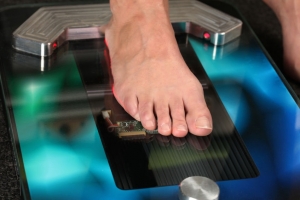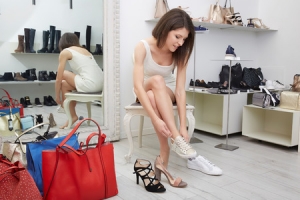Connect With Us
Blogs
Displaying items by tag: custom orthotics
FAQ’s about Custom Orthotics
At Superior Foot & Ankle Care Center we often get questions from our Los Angeles County patients about custom orthotics. Below are some of the most frequently asked questions about this very effective, non-invasive type of podiatric treatment.
Q: What conditions can orthotics help treat?
A: Orthotics are footwear inserts that are used to provide support and reduce pain, discomfort, pressure or imbalance, and other symptoms caused by a wide range of foot and ankle deformities, injuries, and diseases as well as biomechanical problems. Some common conditions that can be treated with orthotics include flat feet, heel pain, arthritis, bunions, calluses, corns, big toe pain, and neuropathic ulcerations.
Q: What’s the difference between over-the-counter shoe inserts and custom orthotics?
A: Over-the-counter inserts can provide some arch support and treat minor discomfort and pain. Prescription orthotics, however, are made from a mold of your unique foot and therefore better able to address and correct your specific foot issues. Prescription orthotics are also constructed of more durable materials and can last a long time.
Q: What are some common kinds of prescription orthotics?
A: Orthotics come in many shapes and sizes and are made from a variety of materials depending on individual needs. They may take the form of insoles, arch supports, heel pads, or foot cushions. Generally, there are two classifications of orthotics. Accommodative orthotics offer cushioning and reduce pressure on a vulnerable area of the foot. Functional orthotics are used to treat foot problems caused by foot and ankle motion and alignment.
Q: How are custom orthotics made?
A: The first step is to have our podiatrists, Dr. Victoria M. Foley and Dr. Constance Ornelas, conduct a thorough examination of your feet and ankles and evaluate how they are impacting your knees, legs, and lower back. Once the foot doctor has a diagnosis of your podiatric disorder and a complete understanding of the biomechanics of your foot, a mold of your foot will be made from a plaster cast or a specialized computer scan that maps your foot structure and your gait. The podiatrist will then check to make sure the orthotic is fitted properly and monitor your progress.
If you would like to learn more about orthotics and whether or not they can help you, contact our Long Beach office at (562) 420-9800 office for an appointment today.
Keep it Moving for a Healthy Heart
February is American Heart Month and at Superior Foot & Ankle Care Center we know that your feet and your heart have a loving relationship. A healthy heart means good circulation which is beneficial to your feet. Your feet play an important role in a key element of heart health: staying active. We want our Los Angeles County patients to know that regular physical activity is one of the best ways to reduce your risk of heart disease. The American Heart Association recommends adults get in 150 active minutes (2.5 hours) each week. In addition to keeping your heart healthy, there are other benefits of an active lifestyle including:
- Reduced risk of other diseases such as stroke, diabetes, high blood pressure, dementia, and several types of cancer
- Help with weight loss or maintaining an appropriate weight
- Better sleep
- Less anxiety and depression
- Improved bone strength and balance, which decreases fall risk
- Mental sharpness: improved cognition, attention, processing, and memory
Help Your Feet Help Your Heart
For your feet to be able to help you stay active, they too need care and attention. Follow these tips to ensure that your feet and ankles are in tip-top shape for physical activity.
Take Care of Foot Pain—continuing to work out if your feet or ankles hurt is a bad idea. Any podiatric discomfort should be evaluated by our podiatrists, Dr. Victoria M. Foley and Dr. Constance Ornelas. The foot doctor will examine your feet and diagnose any problems that will impede your ability to be active. Your podiatrist can also make recommendations to help you accommodate chronic foot problems like plantar fasciitis and bunions. Shoe modifications, custom orthotics, and other recommendations can help. Make an appointment by contacting our Long Beach office at (562) 420-9800.
Choose Shoes Wisely—what you wear on your feet can have a big impact on the success of any fitness regimen. Be sure the athletic footwear you are using is the right kind for the activity you’ve chosen. Check shoes regularly for signs of wear such as compacted insoles, worn down heels, and rips or tears. Get your feet professionally measured to ensure you’re wearing the correct size.
Mix Up Your Routine—choose a variety of different types of activity each week. A mix of aerobic and strength training will benefit your heart and avoiding repetitive strain and impact is good for your feet.
If you have additional questions about heart health, fitness, and your feet, contact us today.
What’s Behind Hallux Rigidus
Hallux rigidus is a form of degenerative arthritis that affects the big toe and one that we at Superior Foot & Ankle Care Center would rather treat in its earlier stages rather than its later ones. What starts out as stiffness in the toe joint will eventually progress to pain, decreased the range of motion and even a frozen big toe joint as the cartilage continues to deteriorate. Being unable to bend your big toe affects all motions that involve pushing off with the toe. These include essential activities like walking, running, squatting down and climbing stairs. At some point even standing and putting any weight on the toe at all can be extremely painful. In addition, hallux rigidus can lead to the development of other conditions such as bunions, bone spurs and calluses.
Who’s at Risk?
There are a number of factors that can increase your risk of developing hallux rigidus and not all of them are within your control. Structural abnormalities and faulty foot mechanics are often to blame for this disorder and those can be inherited or the result of another condition like flat feet or excessive pronation of the ankles which can cause stress to the toe joint. Hallux rigidus, like other forms of arthritis, may develop in a joint that was previously injured. It can also be the result of overuse of a sport that requires pushing off with the toe or a job where you are frequently squatting or doing other activities that bend the toe.
What Can be Done?
If after assessing the state of your big toe joint through examination and x-rays our podiatrists, Dr. Victoria Foley and Dr. Constance Ornelas diagnose hallux rigidus (or hallux limitus—the same condition at an earlier stage) the next step will be determining the correct treatment plan for you.
The foot doctor may recommend rest, icing and over the counter anti-inflammatory medications such as ibuprofen to bring relief of symptoms. Cortisone injections, changes in shoe choice, custom orthotics and physical therapies are all options that can help increase the range of motion and slow the progression of arthritis. In cases that are too far progressed or where there are additional complications, surgery may be the best option,
To learn more, contact our Long Beach office by calling: 562-420-9800.
Show Your Feet Some Lovin’ With Shoes That Fit
Did you know that August 17th is National I Love My Feet Day? At Superior Foot & Ankle Center we can think of no better way to tell your feet you care then by buying shoes that fit properly and are good for your feet. Many common foot problems can be avoided by wearing the correct shoes for your feet. Here are some tips on shoe shopping:
- Buy shoes based on quality of construction and materials that are designed for the health of your feet not on fads and appearance.
- Be sure any shoes you choose take current foot problems you have into consideration. At your next checkup with our podiatrists, Dr. Victoria Foley and Dr. Constance Omelas, ask if there are special features you should look for or avoid when buying shoes. In many cases, such as with bunions, hammertoes, flat feet or high arches, the foot doctor can make recommendations about shoe design that will decrease discomfort and help prevent a foot condition from getting worse. In some cases, a custom orthotic device may help shift pressure away from an area that hurts. If the podiatrist prescribes an orthotic be sure to bring it with you to try on with the shoes you are considering buying.
- Get your feet professionally measured. Feet can change size as you age. It’s not uncommon to find that one of your feet is larger than the other. You should always buy shoes to fit the bigger foot. Also, don’t assume once you know your size that you all brands will fit the same. Always try on shoes before purchasing.
- Heel heights of 1 inch or less are best. The higher the heel, the more pressure that is exerted on the forefoot. Avoid pointy shoes and those with narrow toe boxes.
- Shop for shoes at the end of the day. That’s when your feet are their largest and most swollen.
- Run your hand around the inside of both shoes to be sure there is no loose stitching or rough spots that might rub on your skin.
- Don’t rush! Try on both shoes and take some time to walk around the store to make sure that shoes fit well and are comfortable from the moment you leave the store.
If you have questions about other foot health care issues contact our Long Beach office by calling: 562-420-9800.




